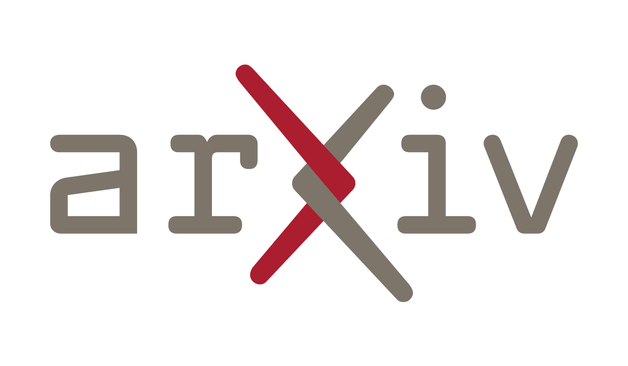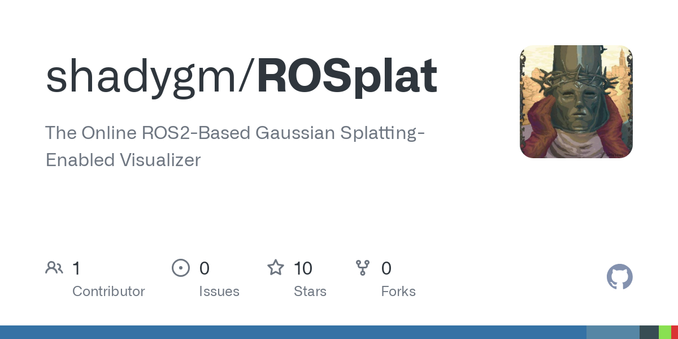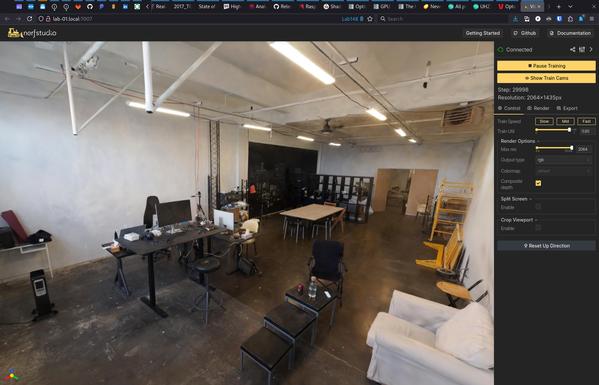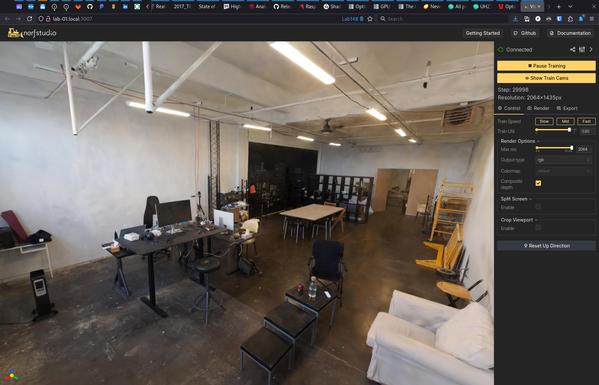https://github.com/shadygm/ROSplat #GaussianSplatting #ROS2 #AIVisualizer #GitHub #TechHumor #Innovation #HackerNews #ngated
https://github.com/shadygm/ROSplat #GaussianSplatting #ROS2 #AIVisualizer #GitHub #TechHumor #Innovation #HackerNews #ngated
Gaussian Splatting Meets ROS2
https://github.com/shadygm/ROSplat
#HackerNews #GaussianSplatting #ROS2 #ComputerVision #MachineLearning #Robotics
🕶️ SeeLe: A Unified Acceleration Framework for Real-Time Gaussian Splatting
https://arxiv.org/abs/2503.05168
#cs #graphics #software #3d #rendering #technology #gaussiansplatting

SeeLe: A Unified Acceleration Framework for Real-Time Gaussian Splatting
3D Gaussian Splatting (3DGS) has become a crucial rendering technique for many real-time applications. However, the limited hardware resources on today's mobile platforms hinder these applications, as they struggle to achieve real-time performance. In this paper, we propose SeeLe, a general framework designed to accelerate the 3DGS pipeline for resource-constrained mobile devices. Specifically, we propose two GPU-oriented techniques: hybrid preprocessing and contribution-aware rasterization. Hybrid preprocessing alleviates the GPU compute and memory pressure by reducing the number of irrelevant Gaussians during rendering. The key is to combine our view-dependent scene representation with online filtering. Meanwhile, contribution-aware rasterization improves the GPU utilization at the rasterization stage by prioritizing Gaussians with high contributions while reducing computations for those with low contributions. Both techniques can be seamlessly integrated into existing 3DGS pipelines with minimal fine-tuning. Collectively, our framework achieves 2.6$\times$ speedup and 32.3\% model reduction while achieving superior rendering quality compared to existing methods.
地球を担いだThe Titan Atlas。紀元後2世紀の頃の Farnese CollectionをScaniverseで3Dスキャン。
#Scaniverse #gaussiansplatting #FuruhashiLab #古橋研究室 #AoyamaGSC #青学 #GEOlab #PoliMI
https://arxiv.org/abs/2502.14938 #GaussianSplatting #AcademicHumor #MathJargon #ResearchComedy #CrypticPapers #HackerNews #ngated

GS-Cache: A GS-Cache Inference Framework for Large-scale Gaussian Splatting Models
Rendering large-scale 3D Gaussian Splatting (3DGS) model faces significant challenges in achieving real-time, high-fidelity performance on consumer-grade devices. Fully realizing the potential of 3DGS in applications such as virtual reality (VR) requires addressing critical system-level challenges to support real-time, immersive experiences. We propose GS-Cache, an end-to-end framework that seamlessly integrates 3DGS's advanced representation with a highly optimized rendering system. GS-Cache introduces a cache-centric pipeline to eliminate redundant computations, an efficiency-aware scheduler for elastic multi-GPU rendering, and optimized CUDA kernels to overcome computational bottlenecks. This synergy between 3DGS and system design enables GS-Cache to achieve up to 5.35x performance improvement, 35% latency reduction, and 42% lower GPU memory usage, supporting 2K binocular rendering at over 120 FPS with high visual quality. By bridging the gap between 3DGS's representation power and the demands of VR systems, GS-Cache establishes a scalable and efficient framework for real-time neural rendering in immersive environments.
A GS-Cache Inference Framework for Large-Scale Gaussian Splatting Models
https://arxiv.org/abs/2502.14938
#HackerNews #GSCache #GaussianSplatting #AIFramework #MachineLearning #Research #arXiv

GS-Cache: A GS-Cache Inference Framework for Large-scale Gaussian Splatting Models
Rendering large-scale 3D Gaussian Splatting (3DGS) model faces significant challenges in achieving real-time, high-fidelity performance on consumer-grade devices. Fully realizing the potential of 3DGS in applications such as virtual reality (VR) requires addressing critical system-level challenges to support real-time, immersive experiences. We propose GS-Cache, an end-to-end framework that seamlessly integrates 3DGS's advanced representation with a highly optimized rendering system. GS-Cache introduces a cache-centric pipeline to eliminate redundant computations, an efficiency-aware scheduler for elastic multi-GPU rendering, and optimized CUDA kernels to overcome computational bottlenecks. This synergy between 3DGS and system design enables GS-Cache to achieve up to 5.35x performance improvement, 35% latency reduction, and 42% lower GPU memory usage, supporting 2K binocular rendering at over 120 FPS with high visual quality. By bridging the gap between 3DGS's representation power and the demands of VR systems, GS-Cache establishes a scalable and efficient framework for real-time neural rendering in immersive environments.
先週のボルゲーゼ美術館での3Dスキャン修行成果その2『アポロンとダフネ』 ジャン・ロレンツォ・ベルニーニ. 1622年頃。
ダフネが月桂樹に変身する足元の植物化した細い根がキチンと3D化できている点で手応えあり。
#Scaniverse #gaussiansplatting #FuruhashiLab #古橋研究室 #AoyamaGSC #青学 #GEOlab #PoliMI
Nous poursuivons nos expérimentations avec les gaussian splatting, pour trouver la meilleure manière de les intégrer dans nos processus de travail notamment dans le contexte d'installations immersives.
Les notes de nos récents essais sont disponibles ici, pour les curieux !
Sketch and patch: efficient 3d gaussian representation for man-made scenes, by Shi et al. 2025
https://arxiv.org/pdf/2501.13045
Great to see research moving into primitives beyond classical Gaussian Splats. GS is nice, but certainly not the end station for realistic scene rendering. Combinations of different Gaussian kernels and/or different primitive types will most likely win in attaining the holy grail of realistic results, high render performance and compact storage.
I can't wait to see this tech enabling holographic reproductions of sports in AR. I want to watch a full Phoenix Suns game or Sydney Kings game in AR from all angles!
https://www.visoric.com/en/gaussian-splatting-the-future-of-3d-visualization


